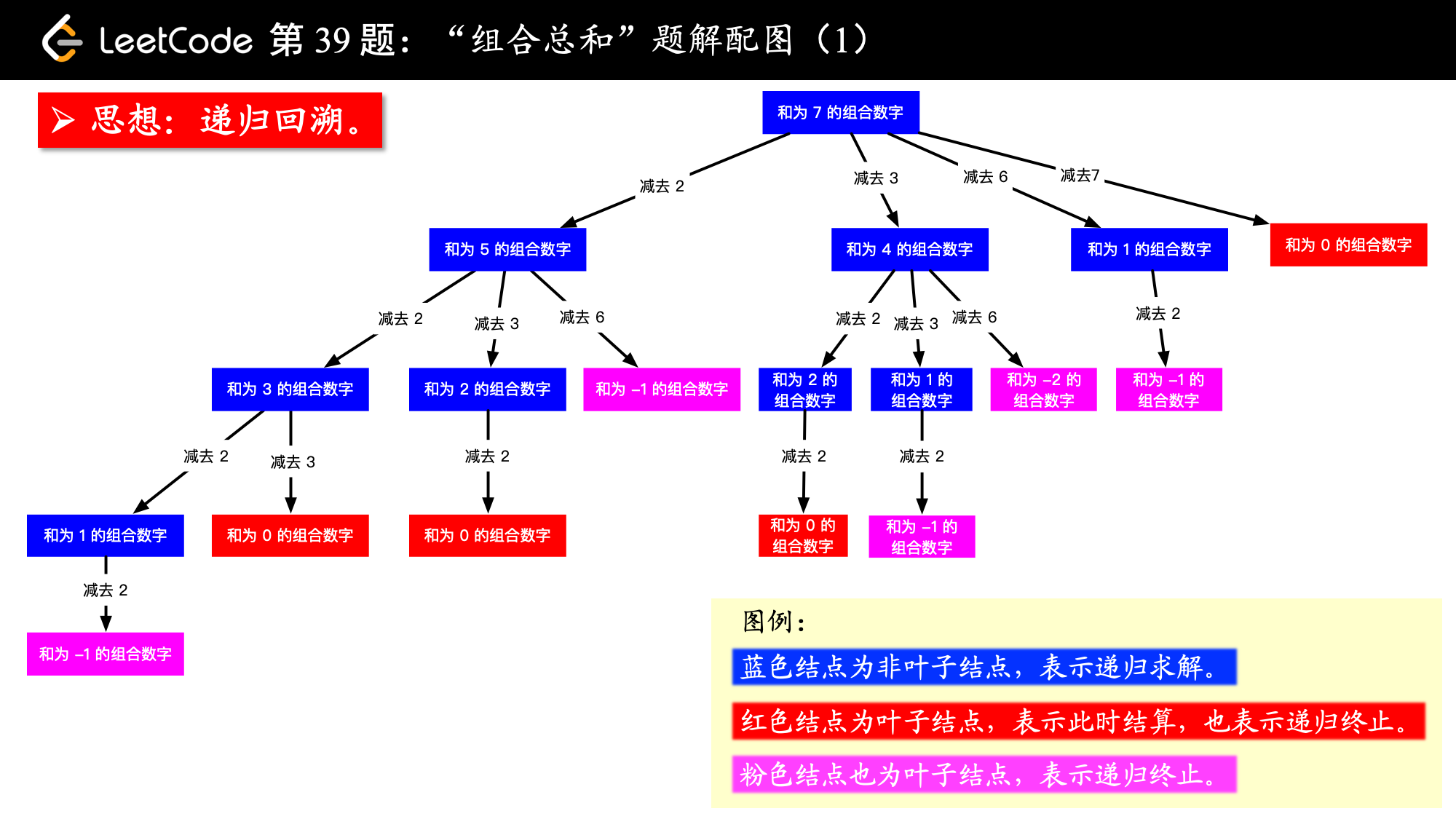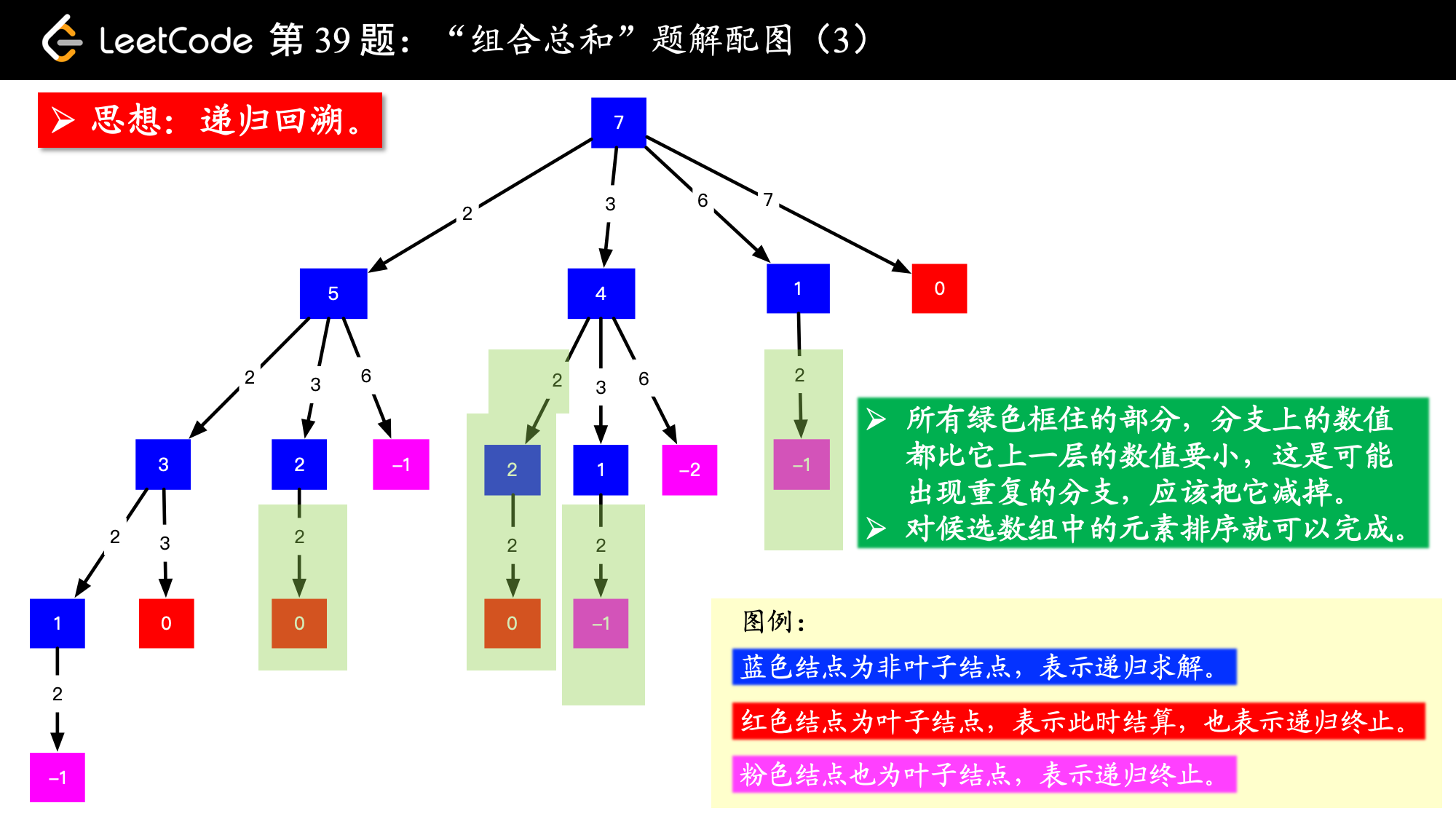先排序后回溯,加法回溯逼近target,减法回溯逼近0。
题目
给定一个无重复元素的数组 candidates 和一个目标数 target ,找出 candidates 中所有可以使数字和为 target 的组合。 candidates 中的数字可以无限制重复被选取。 说明: 所有数字(包括 target)都是正整数。 解集不能包含重复的组合。
示例
示例 1:
| 输入: candidates = [2,3,6,7], target = 7,
所求解集为:
[
[7],
[2,2,3]
]
|
示例 2: | 输入: candidates = [2,3,5], target = 8,
所求解集为:
[
[2,2,2,2],
[2,3,3],
[3,5]
]
|
考察知识点
数组、回溯算法
| result = []
def backtrack(路径, 选择列表):
if 满足结束条件:
result.add(路径)
return
for 选择 in 选择列表:
做选择
backtrack(路径, 选择列表)
撤销选择
|
核心思想
方法一、减法回溯
基本思路:
根据示例 1:输入: candidates = [2,3,6,7],target = 7,输出:[[2, 2, 3], [7]],候选数组里有 2 ,如果找到了 7 - 2 = 5 的所有组合,再在之前加上 2 ,就是 7 的所有组合; 同理考虑 3,如果找到了 7 - 3 = 4 的所有组合,再在之前加上 3 ,就是 7 的所有组合,依次这样找下去; 上面的思路就可以画成下面的树形图。
 1.png
1.png
蓝色结点表示:尝试找到组合之和为该数的所有组合,怎么找呢?逐个减掉候选数组中的元素即可; 以 target = 7 为根结点,每一个分支做减法; 减到 0 或者负数的时候,到了叶子结点; 减到 0 的时候结算,这里 “结算” 的意思是添加到结果集; 从根结点到叶子结点(必须为 0)的路径,就是题目要我们找的一个组合。
改进方案:
 2.png
2.png
画出图以后,我看了一下,我这张图画出的结果有 4个 0,对应的路径是 [[2, 2, 3], [2, 3, 2], [3, 2, 2], [7]],而示例中的解集只有 [[7], [2, 2, 3]],很显然,重复的原因是在较深层的结点值考虑了之前考虑过的元素,因此我们需要特别设置“下一轮搜索的起点”。
去重复
- 在搜索的时候,需要设置搜索起点的下标 begin ,由于一个数可以使用多次,下一层的结点从这个搜索起点开始搜索;
- 在搜索起点 begin 之前的数因为以前的分支搜索过了,所以一定会产生重复,一定要去掉。
剪枝提速
- 如果一个数位搜索起点都不能搜索到结果,那么比它还大的数肯定搜索不到结果,基于这个想法,我们可以对输入数组进行排序,以减少搜索的分支。
- 排序是为了提高搜索速度,非必要。
- 搜索问题一般复杂度较高,能剪枝就尽量需要剪枝。把候选数组排个序,遇到一个较大的数,如果以这个数为起点都搜索不到结果,后面的数就更搜索不到结果了。
- 剪枝:执行用时 :48 ms, 在所有 Python3 提交中击败了96.58%的用户。内存消耗 :13.5 MB, 在所有 Python3 提交中击败了30.29%的用户。
- 不剪枝:执行用时 :88 ms, 在所有 Python3 提交中击败了46.61%的用户。内存消耗 :13.5 MB, 在所有 Python3 提交中击败了30.29%的用户。
代码步骤
1、获取condidate长度,对[]做特判。先对输入的candidates进行排序,为后面的剪枝做准备。剪枝是为了提速,在本题非必需。声明path变量在遍历的过程中记录路径,它是一个栈。以及res变量,保存path。调用回溯函数,注意要传入 size ,在 __dfs 中,size会变化, 这里传进去一个固定的。
2、定义__dfs回溯函数
2.1、先写递归终止的情况,由于是减法回溯,所以最终停止的条件是target被减成0。Python 中可变对象是引用传递,因此需要将当前 path 里的值拷贝出来 或者 使用 path.copy()。
2.2、然后写入选择列表,首先计算残差。然后进行“剪枝”操作,之前已经把候选数组排序了,遇到一个较大的数,如果以这个数为起点都搜索不到结果,后面的数就更搜索不到结果了,不必递归到下一层,并且后面的分支也不必执行,直接break。
2.3、将当前candidates[index]添加到path中。
2.4、调用__dfs,递归寻找,需要特别设置“下一轮搜索的起点”,以防止重复,因为下一层不能比上一层还小,否则就会和前面的重复,起始索引还从 index 开始,不需要从第一个开始。
2.5、当前回溯结束之后,执行撤销选择(弹栈)
大佬题解
方法二、加法回溯
和方法一的思路一致,先排序,后回溯。不过把减法改成了加法。
Python版本
方法一的实现
1
2
3
4
5
6
7
8
9
10
11
12
13
14
15
16
17
18
19
20
21
22
23
24
25
26
27
28
29
30
31
32
33
34
35
36
37
38
39
40
41
42
43
44
45
46
47
48
49
50
51
52
53
| from typing import List
class Solution:
def combinationSum(self, candidates: List[int], target: int) -> List[List[int]]:
size = len(candidates)
if size == 0:
return []
candidates.sort()
path = []
res = []
self.__dfs(candidates, 0, size, path, res, target)
return res
def __dfs(self, candidates, begin, size, path, res, target):
if target == 0:
res.append(path[:])
return
for index in range(begin, size):
residue = target - candidates[index]
if residue < 0: break
self.__dfs(candidates, index, size, path + [candidates[index]], res, residue)
print("leet code accept!!!")
Input = [[2,3,6,7], [2,3,5]]
Input1 = [7, 8]
Answer = [
[
[7],
[2,2,3]
],
[
[2,2,2,2],
[2,3,3],
[3,5]
]
]
if __name__ == "__main__":
solution = Solution()
for i in range(len(Input)):
print("-"*50)
reslut = solution.combinationSum(Input[i], Input1[i])
print(reslut)
print(Answer[i])
|
另一种减法回溯的写法,感觉要简洁一点。
1
2
3
4
5
6
7
8
9
10
11
12
13
14
15
16
17
18
19
20
21
22
23
24
25
| class Solution(object):
def combinationSum(self, candidates, target):
"""
:type candidates: List[int]
:type target: int
:rtype: List[List[int]]
"""
if not candidates:
return []
if min(candidates) > target:
return []
candidates.sort()
res = []
def helper(candidates, target, temp_list):
if target == 0:
res.append(temp_list)
if target < 0:
return
for i in range(len(candidates)):
if candidates[i] > target:
break
helper(candidates[i:], target - candidates[i], temp_list + [candidates[i]])
helper(candidates,target,[])
return res
|
方法二的实现
1
2
3
4
5
6
7
8
9
10
11
12
13
14
15
16
17
18
19
20
21
22
23
24
| from typing import List
class Solution:
def combinationSum(self, candidates: List[int], target: int) -> List[List[int]]:
def backtrack(candidates, begin, path, res, length):
if sum(path) == target:
res.append(path[:])
return
for index in range(begin, length):
if (sum(path) + candidates[index]) > target:
break
path.append(candidates[index])
backtrack(candidates, index, path, res, length)
path.pop()
length = len(candidates)
if length == 0:
return []
candidates.sort()
path = []
res = []
backtrack(candidates, 0, path, res, length)
return res
|
一个三行Python版本
| class Solution:
def combinationSum(self, candidates: List[int], target: int) -> List[List[int]]:
if target < 0 or len(candidates) <= 0:
return []
if target == 0:
return [[]]
return self.combinationSum(candidates[1:], target) + \
[[candidates[0]] + cp for cp in self.combinationSum(candidates, target - candidates[0])]
|
有效语法糖
Python可变对象和不可变对象
“Python 中可变对象是引用传递,因此需要将当前 path 里的值拷贝出来“,这句话的意思。首先必须理解的是,python中一切的传递都是引用(地址),无论是赋值还是函数调用,不存在值传递。
可变对象和不可变对象 python变量保存的是对象的引用,这个引用指向堆内存里的对象,在堆中分配的对象分为两类,一类是可变对象,一类是不可变对象。不可变对象的内容不可改变,保证了数据的不可修改(安全,防止出错),同时可以使得在多线程读取的时候不需要加锁。
不可变对象(变量指向的内存的中的值不能够被改变) 当更改该对象时,由于所指向的内存中的值不可改变,所以会把原来的值复制到新的空间,然后变量指向这个新的地址。python中数值类型(int和float),字符串str,元组tuple都是不可变对象。 下面以int类型为例简单介绍。
| a = 1
print id(a)
a += 1
print id(a)
|
可变对象(变量指向的内存的中的值能够被改变) 当更改该对象时,所指向的内存中的值直接改变,没有发生复制行为。python中列表list,字典dict,集合set都是可变对象。下面以list类型为例简单介绍。
| a = [1,2,3]
print id(a)
a += [4,5]
print id(a)
a = a + [7,8]
print id(a)
|
引用传递后的改变
| a = [1,2,3]
b = a
b[0] = 2
s = 'abc'
s2 = s
s2 += 'd'
|
list注意点
| a = [1,2,3]
b = a
a is b
b = a[:]
a is b
a =[ [0]*2 ]* 2
a[0] == a[1]
a[0][0] = 1
a[0] += [1]
a[0] = [1,2]
|

